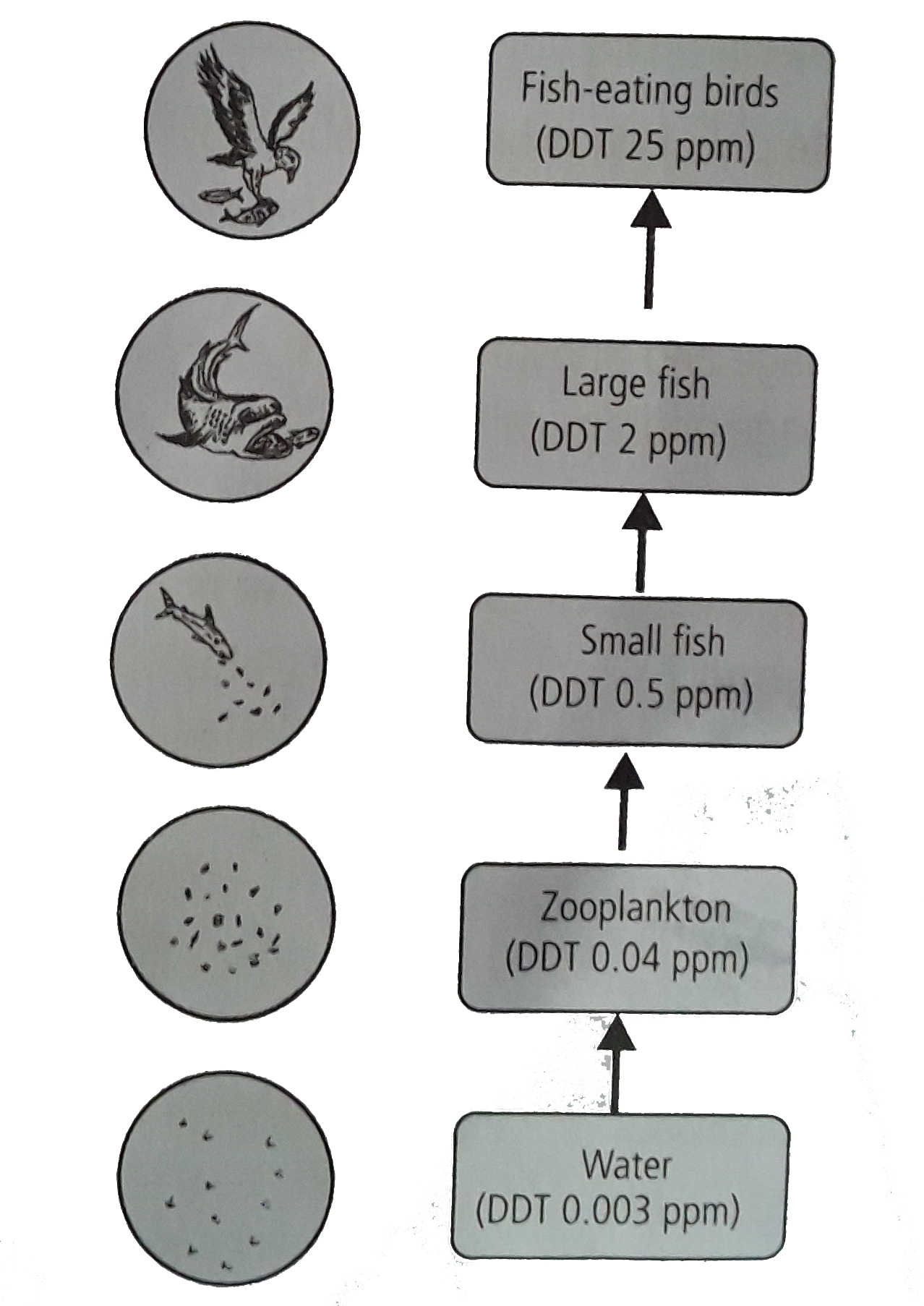Biomagnification of DDT in an aquatic food chain starting from water having a concentration of 0.003 ppb may go, in fish eating birds, upto:
100 ppm
50 ppm
25 ppm
2 ppm
The correct Answer is:C
To solve the problem of biomagnification of DDT in an aquatic food chain, we will follow these steps:
Step 1: Understand the Concept of Biomagnification
Biomagnification refers to the process where the concentration of a substance, such as a pesticide like DDT, increases in the tissues of organisms at each successive level of the food chain. This occurs because organisms at higher trophic levels consume multiple organisms from lower levels, leading to an accumulation of the substance.
Hint: Remember that biomagnification leads to higher concentrations of pollutants at higher trophic levels.
Step 2: Identify the Initial Concentration of DDT
The initial concentration of DDT in the water is given as 0.003 parts per billion (ppb). We need to convert this concentration into parts per million (ppm) for easier calculations.
Hint: Recall that 1 ppm is equivalent to 1000 ppb.
Step 3: Convert ppb to ppm
To convert 0.003 ppb to ppm:
0.003ppb=0.0031000ppm=0.000003ppm
Hint: Use the conversion factor to switch between ppb and ppm.
Step 4: Determine Concentrations at Each Trophic Level
Now we will outline the concentration of DDT at different trophic levels based on the information provided:
- Producers (e.g., phytoplankton): 0.003 ppb (or 0.000003 ppm)
- Primary consumers (e.g., zooplankton): 0.04 ppm
- Secondary consumers (e.g., small fish): 0.5 ppm
- Tertiary consumers (e.g., large fish): 2 ppm
- Quaternary consumers (e.g., fish-eating birds): 25 ppm
Hint: Keep track of how the concentration increases at each level.
Step 5: Identify the Final Concentration in Fish-Eating Birds
From the data, we see that the concentration of DDT in fish-eating birds is 25 ppm. This is the final concentration we are looking for.
Hint: Look for the highest concentration in the food chain as it relates to the question.
Step 6: Conclusion
The concentration of DDT in fish-eating birds, starting from an initial concentration of 0.003 ppb in water, can go up to 25 ppm.
Final Answer: 25 ppm
Biomagnification refers to the process where the concentration of a substance, such as a pesticide like DDT, increases in the tissues of organisms at each successive level of the food chain. This occurs because organisms at higher trophic levels consume multiple organisms from lower levels, leading to an accumulation of the substance.
The initial concentration of DDT in the water is given as 0.003 parts per billion (ppb). We need to convert this concentration into parts per million (ppm) for easier calculations.
To convert 0.003 ppb to ppm:
0.003ppb=0.0031000ppm=0.000003ppm
Now we will outline the concentration of DDT at different trophic levels based on the information provided:
- Producers (e.g., phytoplankton): 0.003 ppb (or 0.000003 ppm)
- Primary consumers (e.g., zooplankton): 0.04 ppm
- Secondary consumers (e.g., small fish): 0.5 ppm
- Tertiary consumers (e.g., large fish): 2 ppm
- Quaternary consumers (e.g., fish-eating birds): 25 ppm
From the data, we see that the concentration of DDT in fish-eating birds is 25 ppm. This is the final concentration we are looking for.
The concentration of DDT in fish-eating birds, starting from an initial concentration of 0.003 ppb in water, can go up to 25 ppm.
Topper's Solved these Questions
- BOOK - DINESH PUBLICATION ENGLISHCHAPTER - ENVIRONMENTAL ISSUESEXERCISE - Check your grasp18videos
ENVIRONMENTAL ISSUES
- BOOK - DINESH PUBLICATION ENGLISHCHAPTER - ENVIRONMENTAL ISSUESEXERCISE - Brain teasers-X145videos
ENVIRONMENTAL ISSUES
- BOOK - DINESH PUBLICATION ENGLISHCHAPTER - ECHINODERMATAEXERCISE - REVISION QUESTIONS65videos
ECHINODERMATA
- BOOK - DINESH PUBLICATION ENGLISHCHAPTER - EVIDENCES OF EVOLUTIONEXERCISE - CHECK YOUR GRASP19videos
EVIDENCES OF EVOLUTION
Similar Questions
Knowledge Check
- Question 1 - Select One
Given figure represents biomagnification of DDT in an aquatic food chain. Select the incorrect statement regarding this.
 AWhen agricultural fields are sprayed with DDT, it is carried by runoff water into nearby aquatic bodies.BRiver water may have a very low concentration of DDT, but the carnivorous fish in that river may contain high concentration of DDT, which is still suitable for consumption by huyman beings.CIncreased concentration of DDT in birds affects calucium metabolism due to which egg shells become thin and break before maturity.DNone of these
AWhen agricultural fields are sprayed with DDT, it is carried by runoff water into nearby aquatic bodies.BRiver water may have a very low concentration of DDT, but the carnivorous fish in that river may contain high concentration of DDT, which is still suitable for consumption by huyman beings.CIncreased concentration of DDT in birds affects calucium metabolism due to which egg shells become thin and break before maturity.DNone of these
In an aquatic food chain, if water body is having 0.003 ppb of DDT, its maximum concentration can be observed in
View SolutionThe highest DDT concentration in aquatic food chain shall occur in
View SolutionThe concentration of DDT in the food chain, from lower to higher trophic levels:
View SolutionThe concentration of DDT in the food chain, from lower to higher trophic levels:
View SolutionThe highest DDT concentration in aquatic food chain shall occur in:
View Solution(a) What depletes ozone in the stratosphere? How does this affect human life?
(b) Explain biomagnification of DDT in an aquatic food chain. How does it affect the bird population?View SolutionDDT contant in the water of a lake that supplies drinking water to the nearby villages, is found to be 0.003 ppm. The kingfishers of that area reported to have 2 ppm of DDT. Why has the concentration increased in these birds ? What harm will this cause to the bird population ? Name the phenomenon.
View Solution

